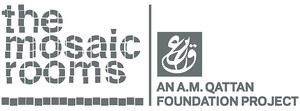When I see the future, I close my eyes
October 1, 2020–March 28, 2021
226 Cromwell Road
London SW5 0SW
UK
Hours: Tuesday–Sunday 11am–6pm
T +44 73709990
info@mosaicrooms.org
The Mosaic Rooms is pleased to announce When I see the future, I close my eyes, the first UK solo exhibition of artist Heba Y. Amin.
Heba Y. Amin’s research-based practice proposes speculative, often satirical, approaches to understanding the enduring impact that technology has on political and territorial realities. Curated by Anthony Downey, When I see the future, I close my eyes presents a series of ongoing works that stem from these issues, including a migratory bird turned international spy, the new digital spaces that were instrumental in Egypt’s revolution in 2011, and a critical survey of historical proposals to drain the Mediterranean Sea. Throughout the exhibition, Amin conveys the ways in which the apparently regional politics of the Middle East, as evidenced in these projects, relate to broader global concerns about surveillance, dictatorships, and the emergence of digital authoritarianism.
Drawing on a true tale of how Egyptian authorities detained a migratory stork in 2013 and accused it of espionage, The General’s Stork investigates the politics of aerial surveillance—against the backdrop of biblical prophecies, drone warfare, and colonial narratives—from a bird’s-eye view. The work utilises film, performance, and archival research material to explore the extent to which Western military techniques of reconnaissance have determined the topographical quartering of the Middle East and how paranoia can become so prevalent that a bird can be accused of spying.
In another extensive work, the artist references the staged elements of dictatorial modes of public address. Throughout Operation Sunken Sea, Amin reveals the historical contexts behind colonial megalomaniacal geo-engineering proposals to drain the Mediterranean Sea and, simultaneously, writes herself into this historical lineage by performatively adopting the persona of a quasi-dictator. Re-purposing the original proposals, Amin broadcasts a speech, recorded live in Malta in 2018, in which she pitches a contemporary “solution” to the so-called migration crisis by relocating the sea within the African continent.
Amin’s ongoing multi-channel video installation Project Speak2Tweet utilises voice messages recorded by phone in response to the Egyptian government’s countrywide Internet shutdown during the first days of the 2011 uprising. Juxtaposed with the abandoned urban structures that represent the long-lasting effects of corruption, the work highlights the extent to which advances in communication technologies are often disguised by their utopian promises of democratic expression.
The exhibition borrows its title from the song Excellent Birds, co-written by Laurie Anderson and Peter Gabriel for video artist Nam June Paik’s 1984 worldwide broadcast Good Morning, Mr. Orwell. Reflecting upon the history of digital media, the use of this title further alerts us to one of Amin’s central interests: the post-digital future of surveillance technologies and emerging forms of digital authoritarianism. In this context, the exhibition is intended as a working tool for producing further original research on these topics, which will in turn modify the works on display. In keeping with this, a project addressing the first aerial photographs of Palestine will be displayed in its early stages of conceptualisation. The ensuing research generated by this project will be published online as the work evolves over the duration of the exhibition.
When I see the future will showcase an extensive programme of events and performances through to March 2021, foregrounding the interdisciplinary methods and performative investigations that provide the impetus for the artist’s practice.
Amin and Downey will also launch their new book, Heba Y. Amin: The General’s Stork (Sternberg Press, 2020), as part of the opening programme.
Heba Y. Amin is a multi-media artist from Egypt. She works with political themes and archival history, using mediums including film, photography, archival material, lecture performance and installation. Amin teaches at Bard College Berlin, is a doctorate fellow in art history at Freie Universität, and a current Field of Vision fellow in New York. She is the co-founder of the Black Athena Collective, curator of visual art for the MIZNA journal, and co-curator for the biennial residency program DEFAULT with Ramdom Association.
Recent exhibitions include the Böttcherstrasse Prize Exhibition, MAXXI Museum, 10th Berlin Biennale, 15th Istanbul Biennale, Künstlerhaus Bethanien Berlin, Karachi Biennale KB17, 11th African Biennale Photography, 12th Dak’Art Biennale Kalmar, FACT Liverpool, Kunsthalle Wien, the Museum of Modern Art in Warsaw, the Kunstverein in Hamburg, Camera Austria, Berlin Berlinale 9th Forum Expanded Exhibition, and the IV Moscow International Biennale for Young Art. Amin is also one of the artists behind the subversive graffiti action on the set of the television series “Homeland” which received worldwide media attention.
Anthony Downey is Professor of Visual Culture in the Middle East and North Africa (Birmingham City University). He is the Commissioning and Cultural Lead on a 4 year AHRC–funded research project (2020-24) that focuses on education, cultural practices, and digital methodologies in Lebanon, Palestine and Jordan. He sits on the editorial boards of Third Text and Digital War, respectively, and is the series editor for Research/Practice (Sternberg Press, 2019–ongoing). Upcoming and recent publications include Unbearable States: Digital Media, Cultural Activism and Human Rights (forthcoming, 2021) and Critique in Practice (Sternberg Press, 2020).



